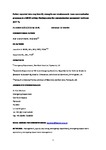Strengths and weaknesses in team communication processes in a UK emergency department setting: findings using the Communication Assessment Tool-Team
Date
2016-06Author
Subject
Metadata
Show full item recordAbstract
<jats:sec> <jats:title>Introduction</jats:title> <jats:p>Identifying weaknesses in emergency department (ED) communication may highlight areas where quality improvement may be beneficial. This study explores whether the Communication Assessment Tool-Team (CAT-T) survey can identify communication strengths and weaknesses in a UK setting.</jats:p> </jats:sec> <jats:sec> <jats:title>Objectives</jats:title> <jats:p>This study aimed to determine the frequency of patient responses for each item on the CAT-T survey and to compare the proportion of responses according to patient and operational characteristics.</jats:p> </jats:sec> <jats:sec> <jats:title>Methods</jats:title> <jats:p>Adults presenting to the minors area of a semi-urban ED between April and May 2015 were included. Those lacking capacity or in custody were excluded. Multivariate analysis identified associations between responses and demographic/operational characteristics.</jats:p> </jats:sec> <jats:sec> <jats:title>Results</jats:title> <jats:p>A total of 407/526 eligible patients responded (77.3%). Respondents were mostly White British (93.9%), with a median age of 45 years. Most responses were obtained during daytime hours (84.2% between 08 : 00 and 18 : 00). The median reported times to triage, assessment and disposition were 15, 35 and 90 min, respectively. Items most frequently rated as ‘very good’/‘excellent’ (strengths) were ‘ambulance staff treated me with respect’ (86.7%), ED staff ‘let me talk without interruptions’ (85%) and ‘paid attention to me’ (83.7%). Items most frequently rated as ‘poor’/‘fair’ (weaknesses) were ‘encouraged me to ask questions’, ‘reception treated me with respect’ (10.4%) and ‘staff showed an interest in my health’ (6.8%). Arrival time, analgesia at triage and time to assessment were associated with significantly increased odds of positive perception of team communication for a range of items.</jats:p> </jats:sec> <jats:sec> <jats:title>Conclusion</jats:title> <jats:p>The CAT-T survey may be used within a UK setting to identify discrete strengths and weaknesses in ED team communication.</jats:p> </jats:sec>
Collections
Publisher
Place of Publication
Journal
Volume
Issue
Pagination
Author URL
Recommended, similar items
The following license files are associated with this item:


